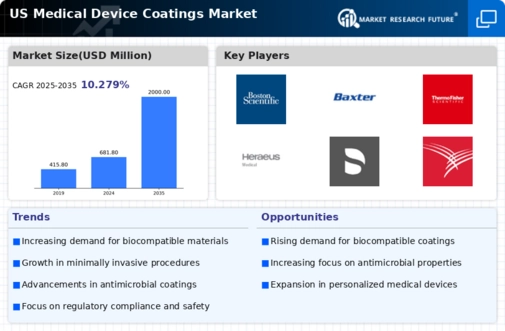The medical device coatings market is characterized by a dynamic competitive landscape, driven by innovation, regulatory advancements, and increasing demand for advanced medical technologies. Key players such as Medtronic plc (IE), Surmodics Inc (US), and Covalon Technologies Ltd (CA) are strategically positioned to leverage their technological expertise and market presence. Medtronic plc (IE) focuses on enhancing its product portfolio through continuous innovation and strategic partnerships, while Surmodics Inc (US) emphasizes its commitment to developing advanced coatings that improve device performance and patient outcomes. Covalon Technologies Ltd (CA) appears to be concentrating on expanding its market reach through collaborations and product diversification, which collectively shapes a competitive environment that is increasingly focused on technological advancement and patient-centric solutions.
In terms of business tactics, companies are increasingly localizing manufacturing to enhance supply chain efficiency and reduce operational costs. The market structure is moderately fragmented, with several players vying for market share, yet a few dominant companies hold significant influence. This competitive structure allows for a diverse range of products and innovations, fostering an environment where companies must continuously adapt to maintain their competitive edge.
In November 2025, Medtronic plc (IE) announced the launch of a new antimicrobial coating technology aimed at reducing infection rates in surgical devices. This strategic move is significant as it not only enhances the safety profile of their products but also aligns with the growing demand for infection control in healthcare settings. By investing in such innovative technologies, Medtronic positions itself as a leader in addressing critical healthcare challenges.
In October 2025, Surmodics Inc (US) entered into a partnership with a leading cardiovascular device manufacturer to develop a next-generation drug-eluting coating. This collaboration is indicative of Surmodics' strategy to leverage partnerships for accelerating product development and enhancing its competitive positioning in the cardiovascular segment. The partnership is expected to yield significant advancements in patient care and device efficacy, thereby strengthening Surmodics' market presence.
In September 2025, Covalon Technologies Ltd (CA) expanded its product line with the introduction of a new biocompatible coating designed for orthopedic implants. This expansion reflects Covalon's strategy to diversify its offerings and cater to the growing orthopedic market. The introduction of such innovative products is likely to enhance patient outcomes and solidify Covalon's reputation as a key player in the medical device coatings sector.
As of December 2025, current competitive trends indicate a strong emphasis on digitalization, sustainability, and the integration of artificial intelligence (AI) in product development. Strategic alliances are increasingly shaping the landscape, enabling companies to pool resources and expertise for enhanced innovation. Looking ahead, competitive differentiation is expected to evolve, with a shift from price-based competition to a focus on innovation, technology, and supply chain reliability. This transition underscores the importance of developing advanced coatings that not only meet regulatory standards but also address the evolving needs of healthcare providers and patients.






















Leave a Comment